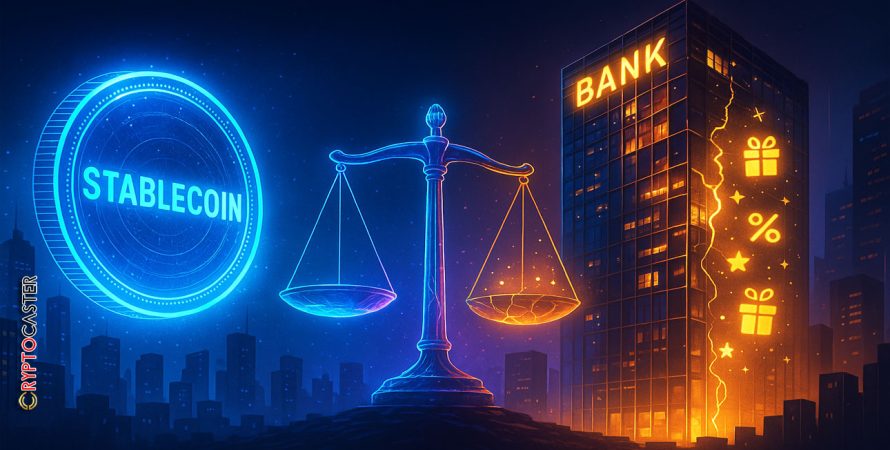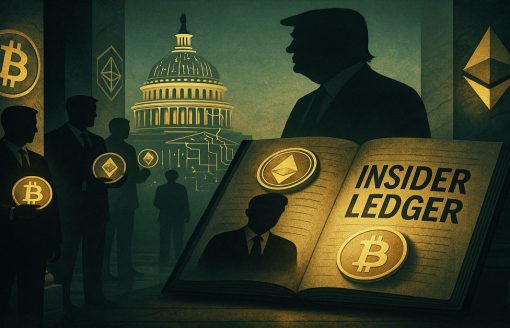By CryptoCaster Editorial Desk
The law that “settled it”—and what it actually settled
Congress’ GENIUS Act established the first comprehensive U.S. framework for payment stablecoins, including chartering pathways, reserving requirements, and conduct rules. Crucially, it prohibits permitted payment stablecoin issuers (and foreign issuers) from paying “any form of interest or yield” to holders solely for holding, using, or retaining a stablecoin—in cash, tokens, or anything of value. Law-firm briefs and the bill text are unambiguous on that element.
Stay in the know on crypto by frequently visiting Crypto News Today
But that clarity left an edge-case: what if affiliates, platforms, or exchanges (not the issuer) offer perks or rewards? Many analyses note the statute focuses on issuers, not every possible third party. That omission created the policy vacuum where today’s clash lives.
The new front: “rewards” vs. “interest”
Since enactment, U.S. banking trade groups have pressed Congress and regulators to treat rewards as functionally equivalent to interest, warning that circumvention through platforms could erode the bank deposit base and destabilize credit creation. In August, national and state bankers publicly urged lawmakers to tighten the GENIUS Act so rewards can’t be used to route around the interest ban.
Their case, in brief:
- Form vs. substance. If a platform pays a user for passively parking stablecoins—even if the issuer isn’t paying—the economic reality mimics interest, they argue. Close the back door before it scales.
- Systemic migration risk. If rewards become the norm, trillions could shift out of insured deposits into platform balances—pressure the cost of funding for banks and, by extension, for families and businesses. (European asset-manager commentary and global regulators echo variants of this concern.)
CryptoCaster Quick Check:
Crypto industry groups counter that rewards can be lawful, non-issuer promotions—akin to credit-card points or cash-back—especially where exchanges face their own compliance regimes, disclosures, and tax reporting. They argue the banker case overstates deposit flight and ignores that stablecoins are fully reserved, not maturity-transforming quasi-banks.
Media and policy coverage now routinely frames this as the “rewards loophole” fight—the second chapter of stablecoin regulation playing out after the first big win on the issuer-interest ban.
Why this is being “relitigated” now
Policy never ends at passage. It continues through interpretation and implementation. On September 19, 2025, Treasury opened an advance notice of proposed rulemaking (ANPRM) for the GENIUS Act, asking the public to weigh in on definitions, supervisory boundaries, and enforcement contours. That comment window is the natural battlefield for both sides to re-argue scope—including whether to corral rewards under the spirit of the interest ban. Comments are due in October.
Bank groups see the ANPRM as the best shot to codify substance-over-form treatment for any economic yield tied to passive holding—no matter who pays it. Crypto coalitions, issuers, and platforms will push the opposite: stay faithful to statutory text (issuers cannot pay interest), but do not criminalize promotions offered by regulated intermediaries or affiliates. The procedural moment makes the “relitigation” narrative feel real, even if it’s technically implementation.
The stakes: deposits, rails, and where innovation lives
From a banking vantage point, every dollar winning a reward to sit in stablecoin form is a dollar not sitting in an FDIC-insured deposit supporting local lending. In stressed contexts, that marginal flow matters. From the crypto vantage point, rewards are the on-ramp catalyst that keeps users in compliant U.S. venues rather than pushing activity offshore, where surveillance and consumer-protection outcomes are worse. Both sides invoke financial stability—they just locate it in different places.
Zoom out: analysts forecast that U.S.-regulated, fully reserved stablecoins could scale toward the trillions as programmable settlement rails replace legacy cards and wires in certain use-cases. If rewards meaningfully boost adoption, the competitive landscape between bank deposits and tokenized cash changes faster—and the political economy of money follows. That’s why this isn’t a footnote.
What the text actually allows (and what it doesn’t)
Three points of ground truth to keep straight while the narratives spar:
- Issuer interest is banned. That’s statutory, not just regulatory. If you issue a payment stablecoin under the GENIUS regime, you cannot pay holders interest or yield “in any form” tied to holding/use/retention. Full stop.
- Rewards are not expressly green-lit or banned. The statute focuses on issuers; it doesn’t explicitly outlaw third-party perks for holders. That’s the gray zone now in play at Treasury.
- Treasury has asked for input. The ANPRM invites public comments on definitional and scope questions that can narrow (or preserve) the space for rewards. The next 30–60 days matter.
Neural lens: the three forces shaping the outcome
To make sense of the noise, track three “forces” (a simple mental model our readers can use). These also align with behavioral levers that often predict policy outcomes:
- Authority (who gets to define the term). If Treasury + prudential regulators adopt a substance-over-form definition that treats passive, platform-paid yield as de facto interest, the rewards window narrows. If they hew to issuer-only wording, rewards survive—perhaps with disclosures and caps. (Watch the comment file for how aggressively each side defines “in connection with holding.”)
- Contrast (competing risk frames). Banks emphasize systemic risk via deposit flight; crypto emphasizes consumer choice + onshore compliance. Whichever narrative dominates mainstream outlets and Hill briefings will tilt final rules. Recent coverage shows momentum on both sides.
- Scarcity (time and optionality). The ANPRM window is brief; once proposed rules drop, negotiating room shrinks. Platforms considering reward programs face a now-or-never calculus: launch (with safeguards) or wait for clarity and risk ceding ground to competitors.
A practical compliance map for the next quarter
If you’re an issuer, exchange, or FinTech partner navigating this:
- Map the flow of value. If any reward depends on passive stablecoin balances, isolate it; document non-issuer provenance; assess whether it looks like consideration for holding under a substance test.
- Prefer “promotion,” not “yield.” Time-bounded, non-compounding promotions with clear disclosures may be easier to defend than open-ended APY-like constructs. (Bank groups are specifically targeting APY-like framing.)
- Disclose like a bank, track like a broker. Robust AML/KYC, tax reporting, and consumer disclosures narrow the optics gap that opponents exploit. Keep a record for examiners and for the comment file.
- Engage the ANPRM. If your business stands to win or lose, file comments—with data on user outcomes, fraud rates, and market integrity. Silence is strategy… for someone else.
Bottom line
Are banks trying to “relitigate” what the GENIUS Act already “settled”? In a way, yes—the issuer interest ban is settled, but the scope of “rewards” isn’t. That’s implementation, not insubordination. The decisive question is whether platform-paid perks for passive balances get redefined as de facto interest—or recognized as promotions outside the issuer’s lane. Congress wrote the skeleton; Treasury will add muscle and nerves in the coming weeks. The market will feel it.
If this article brought you clarity, insight, or value—support the work that made it possible.
At CryptoCaster, we report on Web3, crypto markets, and institutional finance with no billionaire owners, no shareholders, and no hidden agenda. While mainstream media bends toward Elon Musk, BlackRock, and JPMorgan narratives, we stay focused on what matters: truth, transparency, and the public interest.
We don’t just cover the headlines—we investigate the power structures behind them. From FTX and Ripple to the quiet push for CBDCs, we bring fearless reporting that isn’t filtered by corporate interests.
CryptoCaster is 100% paywall-free. Always has been. To keep it that way, we depend on readers like you.
If you believe independent crypto journalism matters, please contribute—starting at just $1 in Bitcoin or Ether. Wallet addresses are below.
Your support keeps us free, bold, and accountable to no one but you.
Thank you,
Kristin Steinbeck
Editor, CryptoCaster
Support CryptoCaster: The Unfolding of Money
At CryptoCaster.world, we’re dedicated to bold journalism, sharp insights, and fearless commentary across blockchain, Web3, and crypto markets. Your **Bitcoin contributions** help us stay independent and continue delivering signal over noise.
🚨 CryptoCaster does not offer investment advice. Always DYOR—volatility is real, and risk tolerance matters.
Support our mission. Contribute BTC today.
🔗 Bitcoin Address:
3NM7AAdxxaJ7jUhZ2nyfgcheWkrquvCzRm
Thank you for backing our journalistic lens as we chronicle the Unfolding of Money — a saga still being written in real time.![]()
CRYPTOCASTER HEATMAP








